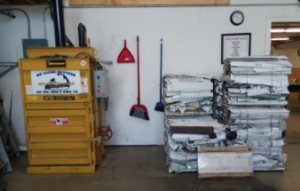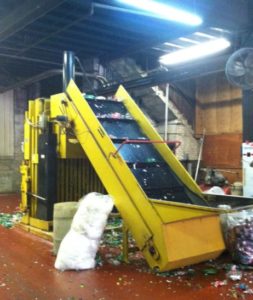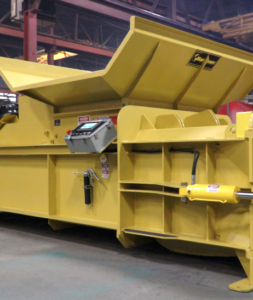Ferrous Metal vs. Non-Ferrous Metal
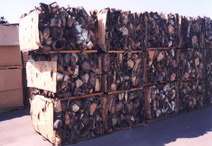
Scrap metal is divided into two types: ferrous and nonferrous. Ferrous scrap metal consists of scrap iron and steel. This includes scrap from old cars, household appliances, steel beams, railroad tracks, ships, food packaging and other containers. Ferrous scrap metal accounts for the largest volume of metal scrapped world-wide.
Nonferrous scrap metal is scrap metal other than iron and steel. Nonferrous scrap metal includes aluminum, foil, cans, copper, lead, zinc, nickel, titanium, cobalt, chromium, and precious metals. While the volume of non-ferrous scrap metal is less then ferrous scrap, it is more valuable by the pound then ferrous scrap metal. That is why so many business owners invest in non-ferrous recycling equipment and processes.
Non-Ferrous Metal Recycling
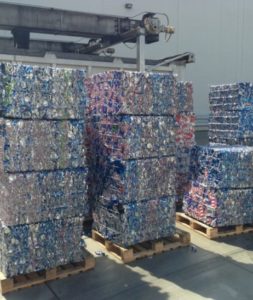 In the United States alone, scrap metal processors handle vast quantities of non-ferrous scrap metal yearly. It is estimated that U.S scrap yards process approximately:
In the United States alone, scrap metal processors handle vast quantities of non-ferrous scrap metal yearly. It is estimated that U.S scrap yards process approximately:
- 1-1.5 million tons of copper scrap annually
- Up to 5 million tons of aluminum scrap annually
- 1.1 million tons of lead scrap annually
- 250,000-300,000 tons of zinc scrap annually
All metals, including both ferrous and non-ferrous, can be recycled indefinitely without loosing any of their properties, an attractive feature to many scrap metal processors. The ever-increasing value of non-ferrous metals from aluminum to exotic metal shavings has resulted in the need for specialized recycling baling equipment. Harmony Enterprises can provide the appropriate solution from our wide range of solutions for any size enterprise, from small metal-fabricating firms to large-scale industrial production facilities.
Benefits to Non-Ferrous Metal Recycling
The use of both ferrous and non-ferrous metals has continued to increase over the years. The amount of aluminum in production alone is astonishing! It is estimated that world primary production of aluminum is around 66 million tons on average per year, of which China, Australia, and Brazil are the largest producers. With metal production in general on the rise, and the valuable resources necessary for their production dwindling, it is more important then ever to find ways to find further value out of scrap metal reuse.
The recovery of non-ferrous metals for recycling provides both environmental and economic benefits. Here are just a few of the reasons you should consider recycling if you generate non-ferrous metal by-products in your operations:
- Non-Ferrous Metal Recycling frees up much needed operational space.
- Non-Ferrous Metal Recycling creates a safer work environment.
- Non-Ferrous Metal Recycling results in less pollution, greater energy savings, and is overall more environmentally friendly.
- Non-Ferrous Metal Recycling creates additional employment opportunities.
- Non-Ferrous Metal Recycling provides additional materials for reuse in manufacturing.
- Non-Ferrous Metal Recycling is a source of additional revenue for your business, and eliminates the need to pay someone else to haul it away.
- Non-Ferrous Metal Recycling encourages the development of additional markets.
TYPES OF Non-Ferrous Metals
Aluminum
Produced from bauxite, aluminum is a clay-like ore that is rich in aluminum compounds. Aluminum is only found as a compound called alumina, which is a hard material consisting of aluminum combined with oxygen. In order to free the aluminum, the alumina has to be stripped of its oxygen, and dissolved in a molten salt at a reduction plant after which a powerful electric current is run though the liquid to separate the aluminum from the oxygen. This process uses large quantities of energy. One of the most cost-effective materials to recycle, aluminum recycling requires a lot less energy then aluminum production. In fact recycling aluminum requires only 5% of the energy and produces only 5% of the CO2 emissions as compared with primary production, all while reducing the amount of waste going to landfill. An additional added bonus is that aluminum can be recycled indefinitely, as reprocessing does not damage its structure.
Other Non-Ferrous Metals
All other non-ferrous metals, though often present in smaller quantities can be recycled as well. These metals which include nickel, copper, silver, gold, lead, and brass are heavily relied on by specific industries, such as the Electronic and Technology Industry. Due to their recognized value, smaller quantities of these metals are in circulation and their ability to be recycled is often neglected when people dispose of these items.
Baling Non-Ferrous Metals
The non-ferrous metal recycling process begins by gathering bulky non-ferrous metals, such as clippings from industrial manufacturing process, aluminum beverage cans, and obsolete scrap, and baling these materials into various sized blocks of bales. Front-end loaders and conveyors, along with other waste handling equipment, are utilized to feed the bulky materials into the baler.
Harmony Enterprises manufactures the widest range of non-ferrous recycling balers. They range in size from 30″ to 72″ in our vertical space-saving designs to larger horizontal models designed for larger volume operations. Our T60XDRC is designed to feed bulky materials at via a conveyor to be compressed at a very high pressure, into dense, uniformly sized bales, which are able to be efficiently re-melted by our customers.
Other vertical balers, like the M60STD are designed to compress bulky material at lower pressure into bigger, less dense, uniformly sized bales, allowing them to be more efficiently stored and transported to consumers who require certain material delivered in this form. One of the most popular non-ferrous balers offered by Harmony is our HM-60NF. This innovative horizontal baler can be fed in a variety of ways including tipper or conveyor. Its smart bale and shear blade technology allow you to automatically cycle non-ferrous metals into your desired weight of bale quickly and easily.
In addition, our full line of ExtractPack liquid extraction balers are all designed to perforate, drain, and bale products stored in non-ferrous containers like aluminum cans.
Non-Ferrous Metal Bale Weights
Actual bale weights of non-ferrous metal vary greatly depending upon the type of material being baled, and actual size and configurations of the non-ferrous baler itself. Below you will find some common loose and baled weights of non-ferrous metal and various other materials.
| Type of Material | Loose | Baled |
| Cardboard | 50 – 100 lbs /cy | 600 – 1100 lbs / cy |
| PET (Soda bottles, food packaging etc) | 30 – 40 lbs / cy | 200–500 lbs / cy |
| HDPE (Milk Jugs, Detergent Containers etc) | 22 – 25 lbs / cy | 200 – 500 lbs / cy |
| Aluminum Cans | 50 – 75 lbs / cy | 150–500 lbs / cy |
| Steel Cans | 150 – 175 lbs / cy | 500 – 1,000 lbs / cy |
| Paper | 500– 600 lbs / cy | 1,000 – 1,200 lbs / cy |
| Newspaper | 350 – 500 lbs / cy | 750 – 1,000 lbs / cy |
Each of Harmony’s non-ferrous balers has estimated bale weight information on each individual product page.
Contact Harmony Today!
The process needed to ensure the right non-ferrous recycling baler for your business should not be taken lightly. Contact Harmony to talk through your exact needs, schedule a free site review, or get a quote on any model today! Our professional sales team will use our proven process to make sure you are completely satisfied from sales through implementation of your equipment. Give us a call at (507) 886-6666 or Contact Us to start recycling non-ferrous metal today!
